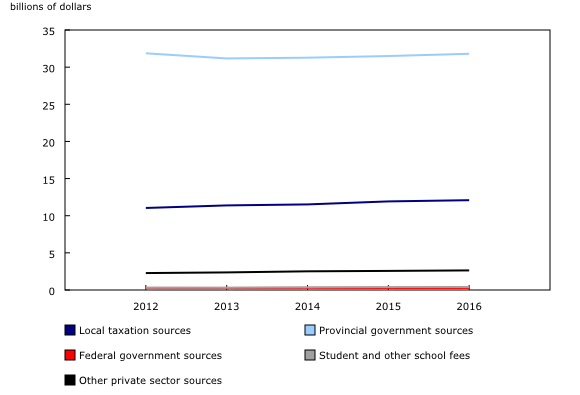Public elementary and secondary school board revenues and expenditures, 2016/2017 (revised data)
Archived Content
Information identified as archived is provided for reference, research or recordkeeping purposes. It is not subject to the Government of Canada Web Standards and has not been altered or updated since it was archived. Please "contact us" to request a format other than those available.
Released: 2019-09-12
Total expenditures for public elementary and secondary school boards and districts across Canada increased 1.0% from the previous fiscal year to $47.7 billion in 2016/2017. Total revenues increased 1.2% to $47.2 billion.
The increase in total revenues in 2016/2017 coincided with a growing student population in Canada. During this period, the number of students enrolled in public elementary and secondary schools grew by 1.1% to 4.8 million.
Provincial and territorial governments remain the largest source of revenue for schools
Canadian public elementary and secondary schools received $31.8 billion from provincial and territorial governments in 2016/2017, accounting for two-thirds (67.4%) of total revenue nationally.
While the share of revenue from provincial and territorial governments has declined by 2.2 percentage points since 2012/2013, these governments have remained the largest source of revenue for Canadian public elementary and secondary schools since 1968. Prior to 1968, local taxation accounted for the largest share of revenue. However, the amount of money received from provincial and territorial governments differed markedly in 2016/2017, ranging from 99.4% in Newfoundland and Labrador to 54.9% in Manitoba.
The largest increase in revenue came from all private sources (+2.6%) in 2016/2017, mainly student fees and ancillary operations. Since 2012/2013, revenue from all private sources (+17.4%) has markedly outpaced revenue from all government sources (+2.2%).
Investment in capital rises by one-fifth in five years
Public elementary and secondary schools in Canada spent $4.1 billion on capital projects in 2016/2017, up 1.4% from a year earlier and up 21.4% from 2012/2013. From 2012/2013 to 2016/2017, debt charges incurred on capital expenditures decreased by 12.3% to $597.1 million.
Capital spending rose in eight provinces and Yukon from 2012/2013 to 2016/2017, and were stable in the Northwest Territories. Capital spending declined in Prince Edward Island, British Columbia and Nunavut. Capital expenditures include new school construction costs, additions, renovations, and the purchase of equipment, buses and furniture.
Educator salaries and benefits increase for third consecutive year
Educator salaries and benefits accounted for two-thirds (67.4%) or $29.0 billion of the total operating expenses of public elementary and secondary schools in 2016/2017, up 0.8% from the previous school year. This was the third consecutive annual increase. The rise in 2016/2017 was in part attributable to a 1.3% increase in educators from 2015/2016. After adjusting for inflation, the annual statutory salaries of public teachers declined by 0.4% from 2015/2016 to 2016/2017.
Educator salaries and benefits include the total wages and benefits paid to personnel who are directly involved in providing kindergarten, elementary and secondary courses. These personnel include full-time and part-time teachers, principals, vice principals, supply teachers and student assistants. Also included in the benefit expenditures are costs related to employer contributions to teachers' pension plans, which are partially or entirely paid by school boards and districts in seven provinces and territories.
Administration costs decline
Total expenses for the general regulation and control of school boards and districts, as well as the overall supervision and administration of instructional programs decreased by 0.5% to $2.4 billion in 2016/2017. These expenditures accounted for 5.6% of total operating expenses.
New interactive tool
To further explore public elementary and secondary school board financial statistics in a visual format, visit the "Public Elementary and Secondary Education Financial Statistics: Interactive tool." Clicking within the tool allows you to filter, highlight and select various provincial and territorial aggregations to create custom measures, charts and graphics.
Note to readers
Data are from the Survey of Uniform Financial System – School Boards. The objective of this annual survey is to collect financial information on school boards and districts across Canada. These financial statistics are collected from every province and territory—with the exception of Nunavut, where data are estimated—and are converted into a standard classification. Data for this survey are not available at the school board and district level.
Employer contributions to teachers' pension plans are partially or entirely paid by school boards and districts in Newfoundland and Labrador, Prince Edward Island, Nova Scotia, New Brunswick, Saskatchewan, British Columbia and the Northwest Territories.
Student enrolment figures and educator trends are from the Elementary–Secondary Education Survey. Annual statutory teachers' salaries are from Education Indicators in Canada: An International Perspective.
All dollar figures are adjusted for inflation unless otherwise specified.
Debt charges include only the interest portion of repayment made by the schools.
Caution should be taken when comparing provinces directly since provinces have different funding formulas and structures.
Contact information
For more information, or to enquire about the concepts, methods or data quality of this release, contact us (toll-free 1-800-263-1136; 514-283-8300; STATCAN.infostats-infostats.STATCAN@canada.ca) or Media Relations (613-951-4636; STATCAN.mediahotline-ligneinfomedias.STATCAN@canada.ca).
- Date modified:


